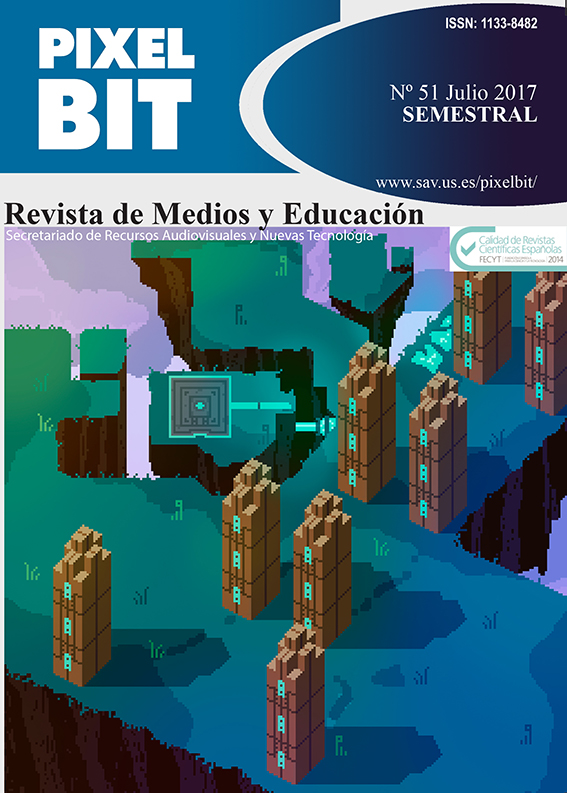Resumen
En el artículo se recogen datos sobre cómo se han incorporado las tecnologías en los hogares y cómo dicha inclusión ha repercutido en el uso cada vez mayor de niños y niñas en edades más tempranas. Panorama que plantea una línea de estudio que parte de las teorías de Piaget y Vigotsky en las se aprovecha el juego digital como estrategia de aprendizaje para los pequeños y en la que el adulto es el "andamiaje" fundamental. Muestra la importancia del ambiente positivo familiar y escolar en el uso de las tecnologías para que la ZPF promueva la motivación en el niño y maximice su experiencia.Citas
Australian Government. Department of Health and Aging (DoHA) (2009). Get up and grow: Healthy eating and physical activity for early childhood. Disponible en http://www.health. gov.au/internet/main/publishing.nsf/Content/EDFEDB588460BCE3CA25762B00232A13/$File/gug-directorscoord.pdf
Basawapatna, A., Repenning, A., Kyu, H.K., & Nickerson, H. (2010). The Zones of Proximal Flow: Guiding students through a space of computational thinking skills and challenges. En ICER '13: International Computing Education Research Conference, August 12-14, San Diego, California, USA.
Camargo, D.M & Orozco, L.C. (2013). Factores asociados a la disponibilidad y uso de medios electrónicos en niños desde preescolar hasta 4º grado. Biomédica, 33, 175-185.
Cánovas, G. (Dir.) (2014). Menores de Edad y Conectividad Móvil en España: Tablets y Smartphones. Madrid: Centro de Seguridad en Internet para los Menores en España: PROTEGELES.
Csikszentmihalyi, M. (1990). Flow: The Psychology of Optimal Experience. New York: Harper and Row
Csikszentmihalyi, M. (1992). Flow. The Psychology of Happiness. Rider. London.
Davis, M.M., Gance-Cleveland, B., Hassink, S., Johnson, R., Paradis, G. & Resnicow K. (2007). Recommendations for prevention of childhood obesity. Pediatrics. 120(Suppl.4). Disponible en http://dx.doi.org/10.1542/peds.2007-2329E
Davis, G.E. & Tall, D.O. What is scheme?. Disponible en https://homepages.warwick.ac.uk/staff/David.Tall/pdfs/dot2002d-davis-schemes.pdf
Fletcher-Flinn, C. & Suddendorf, T. (1996). Do computers affect the mind? Journal of Educational Computing Research, 15(2), 97-112.
Instituto Nacional de Estadística (INE). Encuesta sobre Equipamiento y Uso de Tecnologías de Información y Comunicación en los Hogares. 3 de octubre 2016. Disponible http://www.ine.es/prensa/np991.pdf
Laevers, F. & Heylen, L. (2003). Involvement of Children and Teacher Style. Leuven: University Press
Lera, Mª J (2007). Calidad de la Educación Infantil: instrumentos de evaluación. Revista de Educación, 343, 301-323. Disponble en http://www.revistaeducacion.mec.es/re343/re343_14.pdf
Marquès, P. (2014). Metainvestigación 2013-14. Uso educativo de las tabletas digitales en Educación Infantil. Informe final. Disponible en http://es.slideshare.net/peremarques/uso-educativo-delas-tabletas-digitales-en-educacin-infantil
Mistry, K.B., Minkovitz, C.S., Strobino, D.M. & Borzekowski, D.L. (2007). Children´s television exposure and behavioural and social outcomes at 5.5 years: Does timing of exposure matters? Pediatrics. 120, 762-769. Disponible en http://dx.doi.org/10.1542/peds. 2006-3573
Montero, Mª L. & Gewerc, A. (2010). De la innovación deseada a la innovación posible. Escuelas alteradas por las TIC. Revista de currículum y formación del profesorado, 14(1), 303-316.
National Association for Sport and Physical Education. Active start: A statement of physical activity guidelines for children from birth to five years. Reston, VA: NASPE Publications; 2002. Disponible en http://www.shapeamerica.org/publications/resources/
NPD Group (2014). Kids’ Tablet Play and Household Ownership Increases. Reports NPD. Disponible en https://www.npd.com/wps/portal/npd/us/news/press-releases/kidstablet-play-and-household-ownership-increases-reports-npd
Observatorio Nacional de las Telecomunicaciones de la Sociedad de la Información (ONTSI) (2014). XLIII Oleada del Panel Hogares “Las TIC en los hogares españoles” (1T/2014). Madrid: Ministerio de Industria, Energía y Turismo de España.
Ofcom (2013). The Comunications Market. Report 2013. Londres: Ofcom.
Piaget, J. (1926). The Language and Thought of the Child. New York: Harcourt, Brace
Piagt, J. (1969). The Mechanisms of Perception. New York: Basic Books
Romero Tena, R. (2011). Posibilidades educativas de los videojuegos y juegos digitales en educación en la etapa Infantil. En V. Marín (coord.), Los videojuegos y los juegos digitales como materiales educativos (pp. 79-107). Síntesis. Madrid, 79-107
Romero, R.; Román, P. & Llorente, Mª C. (2009). Tecnologías en los entornos de Infantil y Primaria. Madrid: Síntesis
Sawyer, R. (2003). Emergence in creativity & development. En R. Sawyer,, V. John-Steiner, S. Moran & D. Feldman,. Creativity & Development, 12-60, Oxford: Oxford University Press.
Siraj-Blatchford, J. & Brock. L. (2015). Early Childhood Digital Play in the Zone of Proximal Flow. Disponible en http://www.schemaplay.com/Docs/CITEI.pdf
Siraj-Blatchford, I. & Mayo, A. (2012). Social Class and Educational Inequality: The impact of parents and schools. Cambridge: Cambridge University Press.
Siraj-Blatchford, J. & Morgan, A. (2009). Using ICT in the Early Years: Parents and Practitioners in Partnership, Practical Pre-School Books
Siraj-Blatchford, J. & Palmer, N. (2011). Knowledge learning processes and ICT in early Childhood education, He Kupu, 2 (5) October, Disponible en http://www.hekupu.ac.nz/Journal%20files/Issue5%20October%202011/Knowledge%20learning%20processes%20and%20ICT%20in%20early%20childhood%20education.pdf
Siraj-Blatchford, J. & Siraj-Blatchford, I. (2006). A guide to developing the ICT curriculum for Early Childhood Education. London:Trentham Books in collaboration with Early Education (The British Association for Early Childhood Education)
Stephen, C. (2010). Pedagogy: the silent partner in early years learning. Early Years, 30(1), 15-28.
Sylva, K., Melhuish, E.C., Sammons, P., Siraj-Blatchford, I. & Taggart, B. (2004). The Effective Provision of Pre-School Education (EPPE) Project: Final report. London: DfES / University of London, Institute of Education.
Sylva, K., Siraj-Blatchford, I. & Taggart, B. (2006). Early childhood environmental rating scale – extension (ECERS-E) (2nd ed.). London: Trentham Books.
Sung, H.Y., Siraj-Blatchford, J., & Kucirkova, N. (2015). Your Guide to Outstanding Early Childhood Practice in ICT. London: Step Forward Publishing.
Tharp, R. and Gallimore, R. (1991). A Theory of Teaching as assisted Performance, in Light, P., Sheldon, S. & M. Woodhead (Eds.) Learning to Think. Oxford: Routledge
Vandewater, E.A., Rideout, V.J., Wartella, E.A., Huang, X., Lee, J.H. & Shim, M. (2007). Digital childhood: Electronic media and technology use among infants, toddlers and preschoolers. Pediatrics, 119 (5) e1006-15. Disponible en http://dx.doi.org/10.1542/ peds.2006-1804 DOI: 10.1542/peds.2006-1804
Vygotsky, L.S. (1978). Mind in society: The development of higher psychological processes. Cambridge, MA: Harvard University Press.
Yelland, N. & Masters, J. (2007). Rethinking Scaffolding in the Information Age. Computers & Education, 48(3), 362–82.

